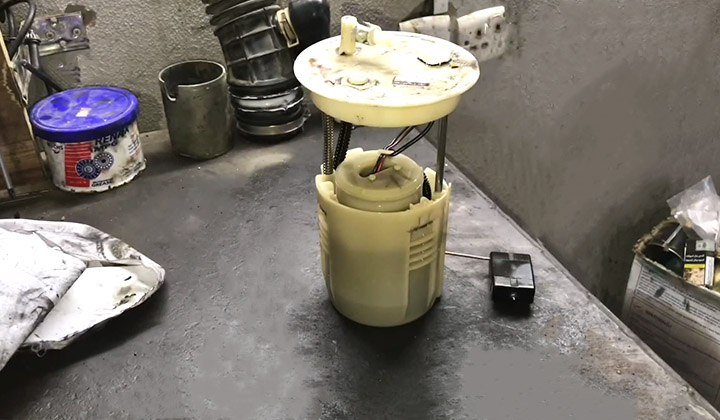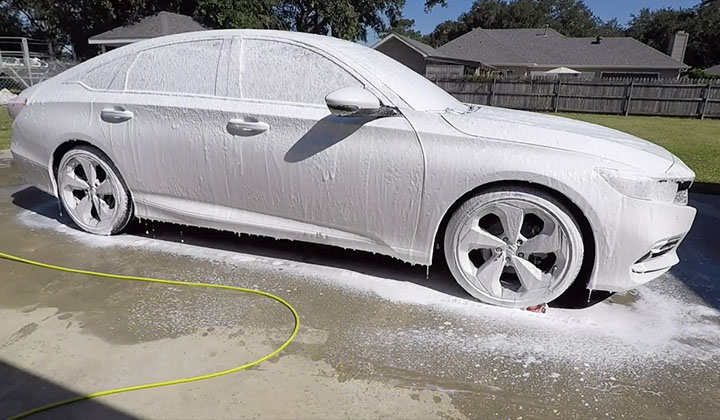The fuel filter prevents small particles and impurities from entering the fuel injectors, ensuring clean fuel delivery. A clogged filter can lead to engine wear, rough running, and starting difficulties.
It is recommended to replace the fuel filter every 30,000 to 50,000 miles. While a professional can replace it quickly, doing it yourself can save money.
Neglecting this maintenance can lead to sluggish performance, especially in challenging conditions, and potentially damage the fuel pump and system in severe cases.
How Do You Change the Fuel Filter In A Honda Accord?
In addition to saving a substantial amount of money, you can do the fuel filter replacement yourself if you are handy. Here’s how to do it:

Disconnect the negative battery terminal after parking your car in a well-ventilated area.
After removing the gas cap, the fuel system can be relieved of any pressure.
The next step is to locate the fuel filter. Accords from 2001 have air filters near the brake master cylinder at the back of the engine.
By rotating the nut counterclockwise, loosen the lower fuel line nut with a 14mm wrench. If gas is spilled during this step, you can catch it with a pan under the fuel line.
Pull the lower fuel line off once you have removed the nut.
Then, rotate the upper fuel line counterclockwise to loosen the Banjo bolt using a 17mm wrench. Take out the fuel line after the nut is removed.
Then, remove the two bolts holding the fuel filter in place with a 10mm flare nut wrench.
The top of the fuel filter should now be free to be removed from the clamp, and you can replace it with a new fuel filter by unclipping the alignment hole.
Fuel lines should be reconnected in a backward fashion. Then, the battery should be reconnected.
Check your filter for any leaks by turning the engine to the ON position.
Consider taking your car to a repair shop if you feel overwhelmed by these steps. Despite the higher cost, you will at least have the assurance that the repair is done correctly.
Change Your Fuel Filter Regularly
Changing your fuel filter regularly is essential to help keep your Honda Accord running smoothly. Several types of filters are available, so find the one that best fits your needs.

Use the manufacturer’s instructions to change the filter and ensure you do it correctly. Avoid over-filtering or under-filtering, as both can cause problems with your engine performance and emissions levels in your car or truck.
Be sure to replace the fuel filter every six months or 12,000 miles, whichever comes first.
Keep Your Car Clean and well-maintained
Keep your Honda Accord running smoothly by regularly changing the fuel filter. This can help avoid costly repairs and ensure a long lifespan for your car.
Fuel filters are small and difficult to access, so take care when doing this yourself. A clogged fuel filter will cause poor engine performance and may lead to an emissions inspection failure.

Be sure to follow the Honda Accord’s owner’s manual instructions when replacing the filter–or have a mechanic do it if you’re not confident in your automotive repair skills.
Avoid Having to Replace an Engine Soon After Changing the Fuel Filter
Changing the fuel filter on your Honda Accord is an easy task you can do yourself in a few minutes. Use the right filter for your car and replace it according to the manufacturer’s instructions.
If you have recently changed your engine, avoid using high-sulfur fuels until the new one has had time to break in properly. Follow these steps if you have problems with poor performance or sudden starts and stops: check air filters, spark plugs, Yoshi exhaust system, etc.
Don’t wait too long before changing your fuel filter – replacing an engine soon after changing its filter can save you money and hassle.
Honda Accord fuel filters are easy to change.
The fuel filter in your Honda Accord is a simple but essential part of the engine that helps to keep the car running smoothly. Changing the fuel filter is easy and can be done by yourself with just a few bolts and screws.
Ensure you have all the necessary tools before you start, including a wrench or pliers for loosening nuts and bolts and an Allen key for removing them. Change your Honda Accord’s fuel filter every six months or 10,000 miles, whichever comes first, whichever feels more comfortable to you as a driver.
Keep your Honda Accord running like new by regularly changing its filters.
FAQ
Does a Honda Accord have a fuel filter?
Honda Accord owners may want to check their fuel filters regularly and replace them as needed. The filter can be loosened by removing the nut from the fuel line, disconnecting the fitting on the engine’s rear, and lifting and removing it.
Owners will also need to loosen the screw at either end of the filter housing for it to be removed easily.
When should I change my Honda fuel filter?
Follow the manufacturer’s guidelines for the proper replacement to ensure a smooth ride every time you hit the road. Keep an eye out for other issues that might require you to change your Honda fuel filter on schedule, including checking emission levels.
Where is the fuel filter on a 2018 Honda Accord?
The fuel filter is located beneath a silver panel with the Honda logo on the left side of the air cleaner box. To access it, you must remove the cover using a flathead screwdriver or wrench, remove the foam sealant around the filter’s edge, and replace it with new filter material.
Route clean gas lines from each cylinder under the hood up to and past the fuel filter before connecting them to your parking brake reservoirs(s).
Where is the fuel filter in a 2016 Honda Accord?
The fuel filter is located on the right side of the engine near the firewall in a 2016 Honda Accord. It should be cleaned every 7,500 miles or as your vehicle’s manufacturer directs.
If you experience problems with starting or running, it may be due to a dirty or failed fuel filter. To replace the filter, remove two screws and then pull out the old one before installing the new one.
How much is a fuel filter for a Honda Accord?
On average, your specific Honda Accord’s fuel filter should be replaced every six months. The replacement cost can range from $192 to $221, depending on your Accord’s make and model year.
Remember that this is an estimate only – prices will vary depending on your specific car and location within the US.
How many filters does a Honda Civic have?
Honda Civics come with two air filters- one in the intake duct and another under the hood. The first filter removes dirt, dust, and other airborne contaminants from your engine.
The second filter helps to improve fuel economy by trapping harmful particles before they reach your exhaust system.
Do you need to change the fuel filter for the Honda Civic?
You should check your Honda Civic’s fuel filter regularly to ensure it is clean and functioning correctly. Disconnect the fuel lines by unscrewing the connector plates at both ends of the line and then removing them altogether.
Remove and clean the old filter using a suitable cleaner before installing a new one on the fuel line connector plate. Reconnect all fuel lines properly, ensuring you seal them at both ends with silicone or another suitable adhesive tape.
To Recap
If your Honda Accord is experiencing decreased fuel economy, the most likely culprit is a clogged fuel filter. To change it yourself, remove the gas cap and unscrew the plastic cover to access the filter.
Remove any dirt or debris from the filter area, replace it with a new one, and screw it back into place. If you have difficulty removing the filter, try using an oil-based cleanser before replacing it.

Can u email me a pic of the fuel filters for a 2018 Honda accord sport 1.5
I’m sorry, but I am not able to send pic as emails.
However, I can help you find the information you need. The 2018 Honda Accord Sport 1.5 has a fuel filter that is located under the hood and near the engine. It is usually located on the left side of the engine area near the two fuel lines, and it is black in a cylinder shape with two bolts holding it into place¹.
Unfortunately, I don’t have any pictures of the fuel filter, but I hope this information helps you locate it. Let me know if you have any other questions.